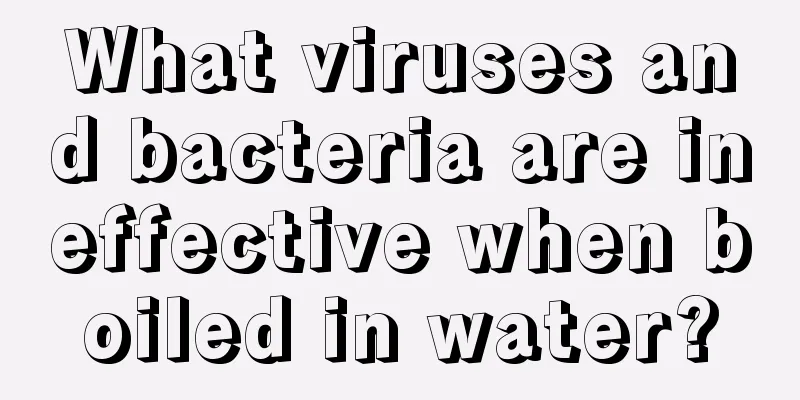What viruses and bacteria are ineffective when boiled in water?

|
High temperature can kill viruses and bacteria. Everyone knows this knowledge, but do you know that some viruses and bacteria cannot be killed even at high temperatures? High temperature can only kill most viruses and bacteria. So, what viruses and bacteria can’t be cured by boiling in water? Let’s take a look at it below. In life, if you encounter these viruses and bacteria, you must take other measures. The basic situation is as follows: 1. Both Thermus rubrum and Bacillus thermotolerant are resistant to high temperatures. 2. Many microorganisms cannot be killed by boiling water in a short period of time and it takes a little longer. 3. Some microorganisms are in a dormant state and are basically impossible to kill. It needs to be inactivated at 120 degrees for half an hour. Generally speaking, pathogenic Escherichia coli, Salmonella, Vibrio cholerae, etc., most of them will not die until they are exposed to high temperature of 100℃ for 1-3 minutes or heated at 80℃ for 10 minutes. Therefore, scalding bowls with boiling water before eating can only kill a very small number of microorganisms. Boiling, circulating steam or using infrared disinfection cabinets are effective methods. Of course, boiling the bowl with water can at least wash away the dust or oil stains in the bowl, which is also acceptable. The difference between living bacteria and viruses 1. Morphology Bacteria are much larger than viruses. The size of bacteria is usually measured in micrometers, while the size of viruses is measured in nanometers. The external shapes of bacteria are mostly spherical, rod-shaped, or spiral-shaped, and they are therefore named cocci, bacilli, and spirochetes. Viruses have a polyhedral structure. In order to achieve the best stable structure and the best specific surface area, viruses are mostly dodecahedrons. 2. Structure Although bacteria do not have a nucleus but only a similar nucleoid structure, they still have a certain cell structure, namely cell wall, cell membrane, and cytoplasm. Furthermore, based on the differences in bacterial cell wall structure and composition, the Gram staining mechanism was developed to divide bacteria into Gram-negative bacteria and Gram-positive bacteria. Viruses do not have the cell structure described above. They are composed of genetic material wrapped in a nucleocapsid. 3. Survival and reproduction Bacteria can be divided into autotrophic and heterotrophic according to their way of survival. That is, some bacteria can survive through photosynthesis (such as some cyanobacteria) or by converting inorganic matter into chemoenergy of organic matter (such as some sulfur bacteria); other bacteria, like humans, cannot synthesize organic matter for their own growth and reproduction and must obtain nutrients from the outside world to feed themselves. Viruses are not as capable as bacteria. They can only survive by parasitizing in the host. Of course, this does not mean that viruses cannot leave the host at all. They can temporarily leave the host and stay in the form of dormant bodies in an environment that is very "harsh" for them. |
<<: What are the benefits and harms of bacteria
Recommend
Will frequent use of a breast pump cause milk to dry up?
A breast pump is an instrument that many women us...
When will kumquat bloom and bear fruit
Many people don’t know much about when kumquat wi...
What are the manifestations and symptoms of periarthritis of shoulder?
Frozen shoulder can cause great damage to our bod...
What are the postoperative symptoms of mid- to late-stage nasopharyngeal carcinoma?
What are the symptoms after surgery for mid- to l...
Under what circumstances can skin cancer be contagious
Skin cancer is the most dangerous skin disease. P...
What causes black eyes and dizziness?
Whether a person's appearance is healthy can ...
What is the best food for teratoma
It was just ordinary menstrual irregularity, but ...
Can toothpaste be used to wash hair?
Toothpaste is used in almost every aspect of our ...
Are nematodes harmful to humans?
There are many tiny worms in our daily life that ...
Why does the flesh turn white after being scalded?
In our daily lives, we come into contact with var...
How long is it appropriate to soak gluten
Gluten is a kind of noodle product, which is very...
How to improve communication and expression skills?
Many friends are constantly improving their commu...
Do I need to exercise if I have prostate cancer effusion? Nursing measures for prostate cancer effusion
The male prostate is very fragile. If you don'...
Physical examination revealed renal cyst
Cysts can occur in any part of the body. The harm...
Proximal phalanx fracture
Proximal phalanx fractures are relatively common....









